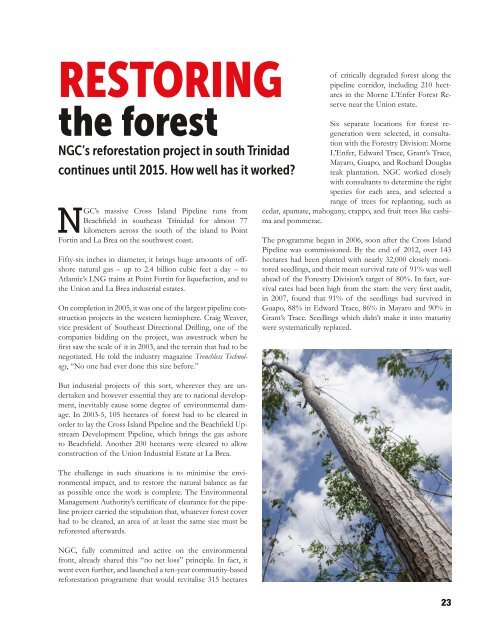GASCO News (Volume 24, November 2013)
Produced for the National Gas Company of Trinidad & Tobago
Produced for the National Gas Company of Trinidad & Tobago
You also want an ePaper? Increase the reach of your titles
YUMPU automatically turns print PDFs into web optimized ePapers that Google loves.
Restoring<br />
the forest<br />
NGC’s reforestation project in south Trinidad<br />
continues until 2015. How well has it worked?<br />
NGC’s massive Cross Island Pipeline runs from<br />
Beachfield in southeast Trinidad for almost 77<br />
kilometers across the south of the island to Point<br />
Fortin and La Brea on the southwest coast.<br />
Fifty-six inches in diameter, it brings huge amounts of offshore<br />
natural gas – up to 2.4 billion cubic feet a day – to<br />
Atlantic’s LNG trains at Point Fortin for liquefaction, and to<br />
the Union and La Brea industrial estates.<br />
On completion in 2005, it was one of the largest pipeline construction<br />
projects in the western hemisphere. Craig Weaver,<br />
vice president of Southeast Directional Drilling, one of the<br />
companies bidding on the project, was awestruck when he<br />
first saw the scale of it in 2003, and the terrain that had to be<br />
negotiated. He told the industry magazine Trenchless Technology,<br />
“No one had ever done this size before.”<br />
But industrial projects of this sort, wherever they are undertaken<br />
and however essential they are to national development,<br />
inevitably cause some degree of environmental damage.<br />
In 2003-5, 105 hectares of forest had to be cleared in<br />
order to lay the Cross Island Pipeline and the Beachfield Upstream<br />
Development Pipeline, which brings the gas ashore<br />
to Beachfield. Another 200 hectares were cleared to allow<br />
construction of the Union Industrial Estate at La Brea.<br />
The challenge in such situations is to minimise the environmental<br />
impact, and to restore the natural balance as far<br />
as possible once the work is complete. The Environmental<br />
Management Authority’s certificate of clearance for the pipeline<br />
project carried the stipulation that, whatever forest cover<br />
had to be cleared, an area of at least the same size must be<br />
reforested afterwards.<br />
NGC, fully committed and active on the environmental<br />
front, already shared this “no net loss” principle. In fact, it<br />
went even further, and launched a ten-year community-based<br />
reforestation programme that would revitalise 315 hectares<br />
of critically degraded forest along the<br />
pipeline corridor, including 210 hectares<br />
in the Morne L’Enfer Forest Reserve<br />
near the Union estate.<br />
Six separate locations for forest regeneration<br />
were selected, in consultation<br />
with the Forestry Division: Morne<br />
L’Enfer, Edward Trace, Grant’s Trace,<br />
Mayaro, Guapo, and Rochard Douglas<br />
teak plantation. NGC worked closely<br />
with consultants to determine the right<br />
species for each area, and selected a<br />
range of trees for replanting, such as<br />
cedar, apamate, mahogany, crappo, and fruit trees like cashima<br />
and pommerac.<br />
The programme began in 2006, soon after the Cross Island<br />
Pipeline was commissioned. By the end of 2012, over 143<br />
hectares had been planted with nearly 32,000 closely monitored<br />
seedlings, and their mean survival rate of 91% was well<br />
ahead of the Forestry Division’s target of 80%. In fact, survival<br />
rates had been high from the start: the very first audit,<br />
in 2007, found that 91% of the seedlings had survived in<br />
Guapo, 88% in Edward Trace, 86% in Mayaro and 90% in<br />
Grant’s Trace. Seedlings which didn’t make it into maturity<br />
were systematically replaced.<br />
23


















